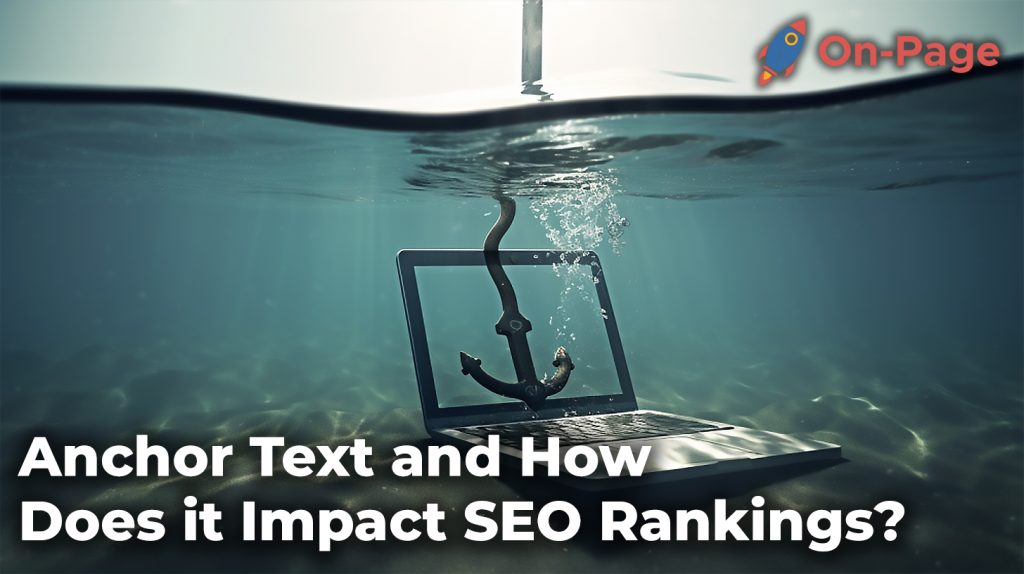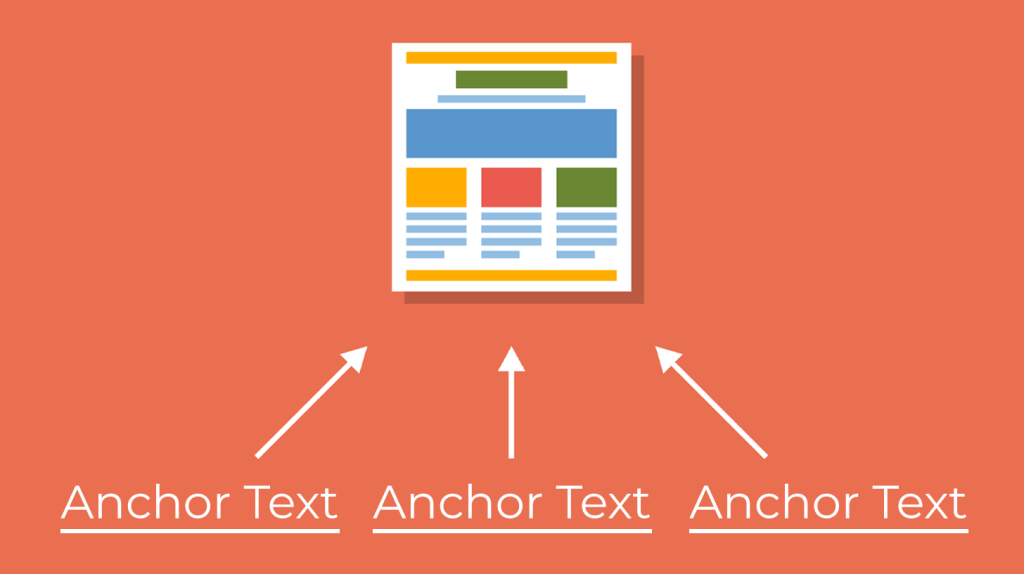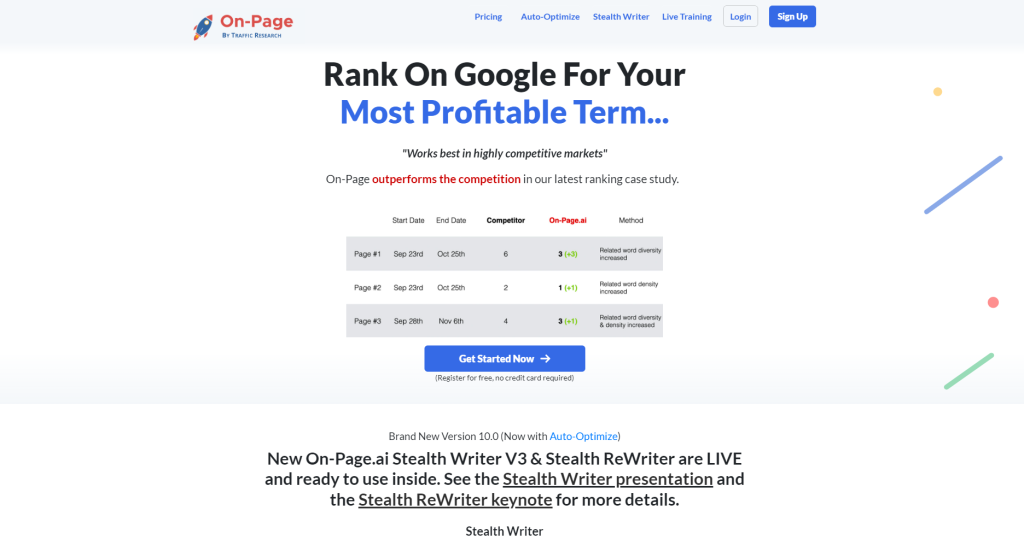
Have you ever clicked on a hyperlink within a blog post only to be whisked away to an entirely new webpage, filled with fresh insights and data? Like opening Pandora’s box, the anchor text of that link played a vital role in your online journey. But what if I told you that this “magic click” holds the power not only to improve user experience but also rocket up the SEO rankings? Read on as we delve into the fascinating world of anchor text and uncover its immense influence on your website’s success!
Anchor text refers to the clickable text within a hyperlink on a web page. It helps search engines understand the content of the linked page and plays an important role in determining the relevance and context of web pages in search engine rankings. Optimizing anchor text with relevant keywords and avoiding generic or non-descriptive phrases can help improve a website’s SEO by signaling to search engines what the linked page is about. However, using too much exact-match or spammy anchor text can trigger Google penalties, so it’s important to use anchor text variation and distribute it evenly among relevant pages on the site.
Understanding Anchor Text
When it comes to Search Engine Optimization (SEO), anchor text is a defining factor in the ranking of a website. Anchor text refers to the clickable words or phrases inside a hyperlink that direct you to another web page. It tells search engine algorithms what the linked page is about and how relevant it is to the keyword searched by the user.

For instance, if you’re an online bookseller and you have a webpage about children’s books, linking to another page with “children’s literature” as your anchor text would describe the new webpage as one relevant to children’s literature. This way, Google crawlers will understand that the linked page is related to children’s literature.
Anchor texts must be chosen wisely and optimized well to reap maximum SEO benefits. To achieve this, there are some important aspects of anchor texts you need to understand.
One question asked by stakeholders is whether they should use generic anchors or descriptive anchors. The answer is not straightforward because both types of anchor text may serve different purposes. While generic anchor texts such as “Click here,” “Read more” and “Learn more” might exist in an email signature or an article bio section, and they might get clicked a few times, studies suggest that descriptive anchors like “The best SEO practices for 2023,” will have a higher click-through rate since users can tell precisely where they’ll land after clicking those links.
Strategic placement of anchor texts also improves their effectiveness in SEO rankings. Proper positioning increases their visibility and accessibility without being intrusive or too aggressive on the reader. For example, placing them within the first hundred words of every blog post gives both readers and search engines early signals regarding the direction and context of content.
- Anchor text is a crucial factor in the ranking of a website for Search Engine Optimization (SEO) as it tells search engine algorithms what the linked page is about and how relevant it is to the keyword searched by the user. Anchor texts must be chosen wisely, optimized well, and strategically placed within the content to reap maximum SEO benefits. Descriptive anchor texts tend to improve click-through rates compared to generic ones, and proper positioning increases their visibility and accessibility without being intrusive or too aggressive on the reader.
Components and Purpose of Anchor Text
A typical hyperlink includes two core components: The link destination (URL) and the clickable texts (anchor text). Anchor texts are typically composed of keywords or their variations. It is important that anchor text keywords be relevant both to the page it’s linking to and its relevance to the overall topic of your website.
For example, let’s consider a scenario in which you operate an online shoe store. Your homepage targets “men’s shoes” as one of its main topics. If you have blog content on men’s dress shoes and you include anchor text that links to one of your product pages for dress shoes, the destination URL should have content related to dress shoes since the anchor text is related to that product.
Strategic use of anchor text can increase traffic to other web pages on your site. This is possible because readers will click through links when they’re provided with well-written, useful content in which those anchors appear, giving search engines an idea about what destination pages’ relevance is while helping users easily find what they want.
We can think about anchor texts as a library index system. Just like you need an index to locate books on different subjects in a library, anchor texts help both humans and machines find specific information within websites. These clickable links provide the context needed by search engines to understand what your website is all about while highlighting essential pieces of content.
Now that we understand the basic concepts behind anchor text let’s delve deeper into the different types of anchor texts that exist and how they relate to SEO scores.
- According to a study conducted by Moz in 2015, anchor text was among the top five factors that influenced Google’s search engine rankings.
- Research by Ahrefs revealed that, on average, pages ranking in position one for a target keyword had a 13% higher exact match anchor text distribution than those ranking at position ten.
- In a 2017 survey by Stone Temple Consulting, it was found that approximately 55% of web pages had optimized their anchor text for improved SEO performance.
Different Types of Anchor Text

When it comes to anchor text, there are various types that can impact SEO rankings in different ways. It is important for website owners and content creators to understand these different types of anchor text and how they can be used effectively.
One common type of anchor text is branded anchor text, which uses the brand name as the linked text. This type of anchor text is typically used when linking to the homepage or other pages related to the brand. For example, a shoe company may use “Nike” as the anchor text when linking to their homepage.
Another type of anchor text is exact match, which uses the exact keyword or phrase being targeted as the linked text. This type of anchor text can be effective in boosting rankings for specific keywords, but it can also be overused and trigger Google’s spam filter.
Partial match anchor text includes variations of the targeted keyword or phrase within the linked text. For example, if a webpage is targeting “best running shoes,” a partial match anchor text could be “top-rated running sneakers.”
Related keyword anchor text uses words or phrases that are related to the targeted keyword within the linked text. This type of anchor text can help boost rankings for related topics and subtopics, as well as add variety to the overall linking strategy.
Naked link anchor text is simply a URL or hyperlink without any added descriptive or keyword-rich wording. Although this may appear unhelpful for SEO purposes, naked links used in moderation can contribute positively to a website’s link profile.
Images can also serve as anchor text through their alt attributes. When an image contains relevant keywords within its alt attribute, it serves as both a visual element and contributing factor to overall on-page optimization.
A car dealership may have its logo serve as branded anchor text when linked to its homepage. Alternatively, they may use a partial match or related keyword-anchored images serving as clickable links when advertising specific services they offer.
It is important to note that the anchor text used should always add value to the user experience, and reflect the content of the page being linked. Exact match anchor text used excessively or without considering user intent can lead to receipt of penalties by search engines.
Some debates have arisen regarding whether diverse anchor text use vs exact match is superior for on-page optimization. While some argue that diversifying links offers robust rankings across related phrases when measured against exact matches, there are still many advantages of using accurate keyword-rich exact match anchor text.
Anchor Text can be compared to puzzle pieces; linking pages with complementary anchors will fit together seamlessly and effortlessly create a larger picture for users. In contrast, using competing or irrelevant anchors can lead to a misshapen impression for both users and search engine algorithms.
Relevance to SEO Rankings

The correct use of anchor text is crucial to a website’s SEO strategy. Search engine algorithms use anchor text as a ranking factor in determining the relevance of a webpage’s content to its target keywords. By correctly using anchor text in conjunction with relevant, high-quality content, you are offering consistent messaging between user expectation and algorithms while indicating relevant topics to crawlers.
Anchor text diversity paired with site authority signals will provide lookup bots with increased functionality and support the display of associated topics within search results. The type of industry and competition being faced will influence which types of targeted anchors work best in attracting site traffic.
Despite differing opinions on the most effective way to use anchors, it is generally agreed upon that over-optimization and spamming should always be availed. A well-executed linking strategy using varied, quality-driven anchors can set up your webpage for organic engagement and increased rankings on search engine result pages.
For example, implementing branding elements into anchor text linking may increase traffic for those searching for specific services you offer, while on the other hand, image-linked anchors with keywords related to services and products are effective at broadening organic reach. Ensuring proper linking strategies can provide you with the benefits of the visibility your site needs in today’s competitive market landscape.
Studying competitor’s linking structures and establishing target content linkages allows creating an influential foundation which will aid any site striving on SEO, increasing site relevancy accompanied with increased page authority.
While numerous arguments exist for exact matches enhancing search engine optimization performance through clear pandering to user intent, employing diverse, relevant anchors demonstrates the scope of a particular website’s relevancy in addition to their focus on improving practical user industry knowledge.
The practical use of anchor text is similar to painting. A done-right approach using variation and cohesion within the painting process best reflects its charm, rather than employing industrial methods that risk overdependence on singular elements.
Anchor Text Optimization Techniques

Anchor text optimization plays a crucial role in SEO rankings, but it’s equally important to understand how to implement it effectively. Balancing keyword variations and avoiding over-optimization are two critical anchor text optimization techniques that have a direct impact on search engine rankings.
For instance, if you’re optimizing your website for the keyword “best SEO tool”, you should use anchor text variations such as “top SEO software” or “most efficient SEO platform”. The idea is to avoid using the exact match keyword repeatedly, which can be perceived as spammy by search engines. It’s also essential to use contextual relevance to ensure that the anchor text complements the content it’s linking to.
Another technique for anchor text optimization is to research your competitors’ link building strategies. Analyzing their backlink profile can give you insights about what type of anchor text is working well for them. You can also identify gaps and opportunities in their strategies and try to improve upon those areas.
While it may be tempting to use exact match keywords as much as possible, over-optimizing anchor text can actually hurt your SEO rankings. In fact, search engines like Google have algorithms designed to detect unnatural linking patterns, especially with anchor text. The penalties for such practices are steep, including being demoted in search results or even being removed from search engine indexes altogether.
So how do you balance keyword variations without over-optimizing? Let’s look at some ways through which you can effectively optimize your anchor text strategy.
Balancing Keyword Variations
One way to balance keyword variations is to create a list of relevant phrases that complement your target keywords. This will help you determine different combinations of anchor texts that maintain consistency with your content themes and overall messaging.
For example, an AI-based SEO company could use anchor text variations such as “AI-powered SEO tool“, “machine learning software for SEO”, or “artificial intelligence-driven SEO platform”. This helps to build a diversified backlink profile and mitigates the risk of over-optimization.
Another analogy to understand this is to treat your backlink profile like an investment portfolio. Diversification is key to managing risks, so you should aim for various types of anchor text such as exact match, partial match, branded, or naked links.
Additionally, using generic anchor text such as “click here” or “read more” can also serve as valuable indicators to search engines about the content on the linked page. This helps with increasing the credibility and authority of your website in relevant searches.
The next section will delve into avoiding over-optimization when balancing keyword variations.
Avoiding Over-Optimization

Anchor text optimization is a crucial part of your SEO strategy, but over-optimization can lead to penalties by search engines. Over-optimization refers to using the same anchor text keyword excessively in all your backlinks. This is viewed by search engines as an attempt to manipulate rankings and can lead to penalties that can harm your website’s visibility. It’s important to avoid over-optimization and balance anchor text usage with other variations.
For instance, if you have a dental clinic and all your backlinks use the same exact match anchor text “dental clinic,” it raises suspicion from Google and could penalize your website. It’s best practice for the anchor text to be more natural-looking and diverse. For example, instead of using the same exact match keyword “dental clinic” each time, you can vary by using “dentist near me,” “dental services,” “teeth cleaning,” and so on.
Over-optimized anchor text does not appear natural to search engines and raises a red flag that indicates that the site owner is trying to manipulate their rankings by artificially inflating their ranking signals. Too much focus on one keyword or phrase can lead to severe consequences like stiff ranking drops or even total removal on search pages. Therefore, always keep your anchor text varied and use targeted keywords sparingly.
However, some people debate whether there is such a thing as over-optimizing for an anchor text phrase. They argue that it may not necessarily be a penalty-causing offence unless it appears very spammy or irrelevant. Nonetheless, research shows that overuse of specific-anchor texts could trigger Google Penguin algorithm updates leading to increased scrutiny of your link profile.
Imagine going for dinner with friends at a restaurant famous for steaks. You keep repeating how delicious the steak tastes to the extent that everyone gets annoyed. The same happens with over-optimized anchor text in your SEO strategy. Overusing a specific phrase creates doubts about your intentions and negatively affects how people perceive your website’s ranking in search engines.
Now that you understand the dangers of over-optimizing anchor texts, let’s dive into another critical part of your SEO strategy – backlinks.
Significance of Backlinks in SEO
Backlinks are links from other websites that point to your site. It is one of the vital ranking signals used by search engines to determine the importance and popularity of a web page. A website that has several high-quality, relevant backlinks appears credible and authoritative. Conversely, sites with fewer or low-quality backlinks may be viewed as less important and may not rank as well on search engine results pages (SERPs).

Suppose you run an online sneaker store, and several reputable footwear bloggers link back to your site when reviewing a product that you sell. This type of endorsement implies that you offer highly valuable content for sneaker enthusiasts and directly contributes to increasing user engagement with your brand by driving traffic to your site. All this ultimately helps increase the chances of ranking higher on SERPs because Google will view your content as more impactful than others.
Research indicates a strong correlation between ranking higher in search engine result pages and the quality and number of backlinks web pages have garnered. When it comes to securing strong inbound links, quality is better than quantity – which means having backlinks from fewer high-authority sites that match your niche rather than numerous links from low-quality sources that do not quite align with what you offer.
However, some people debate if building larger quantities of links regardless of source strength still plays a critical role in delivering positive SEO results or if it is more effective just focusing on improving content quality or paying for advertising. The reality is that more link sources can lead to higher visibility in search engine result pages, but if these are of low quality, it could damage your website’s reputation.
A good analogy to illustrate backlinks and their benefits is like aiming at becoming an expert in a specific industry by attending networking events and meeting influential people in the field. By doing so, you get exposure to opportunities that don’t only come from those connections directly but from companies they work for, where there’s a chance for collaborative projects. Similarly, securing high-quality links gives you access to people with similar interests that potentially build partnership opportunities.
Backlinks can single-handedly move your site up the ranking ladder on SERPs – or bring it down if gathered unwisely. In our next section, we will delve into monitoring and adjusting anchor text strategy to avoid such pitfalls.
Monitoring and Adjusting Anchor Text Strategy
Having a clear understanding of anchor text and implementing techniques to optimize it is only half the battle. To truly improve your website’s SEO rankings, it’s essential to consistently monitor and adjust your anchor text strategy.
With the help of tools like On-Page.ai, you can easily track your website’s anchor text usage and identify any areas that need improvement. It’s important to regularly check for over-optimization or spammy anchor text, which can negatively impact your rankings.

One effective way to monitor your anchor text strategy is by using Google Analytics. You can track how visitors arrive at your website and analyze the anchor text used in their backlinks. This information can be invaluable in adjusting your strategy to target specific keywords or phrases.

For instance, if you notice that a majority of backlinks are using generic anchor text like “click here,” it may be time to rethink your content strategy and focus on creating more relevant and targeted pages.
It’s also important to keep an eye on how your competitors are using anchor text. Analyzing their strategies can give you ideas for improving your own while staying ahead of the competition.
By continuously monitoring and adjusting your anchor text strategy, you can ensure that it remains relevant and effective in improving your website’s rankings.
In addition to monitoring, it’s crucial to actually adjust your strategy when necessary. This could mean updating existing pages with better-optimized internal links or adding new pages that target high-priority keywords.
It’s also worth noting that optimizing anchor text isn’t a one-time fix – it requires ongoing attention and adjustment as search algorithms evolve. By staying informed about best practices and regularly monitoring performance metrics, you can stay ahead of the curve and continually improve your SEO rankings.
In many ways, optimizing anchor text is like gardening – it requires regular care and attention to keep everything growing properly. Just like a garden needs water, sunlight, and pruning to thrive, your website’s anchor text strategy needs monitoring, adjustment, and optimization to succeed.
With its advanced AI-powered tools, On-Page.ai makes it easy to monitor and adjust your website’s anchor text strategy for optimal SEO performance. Whether you’re just starting out or have an existing site that needs improvement, On-Page.ai has the features and services you need to boost your rankings and stay ahead of the competition. So why wait? Sign up today and start optimizing your anchor text for better SEO results!
Frequently Asked Questions and Their Answers
How does search engines use anchor text to rank web pages?
Search engines use anchor text to understand the context and relevance of a web page. Anchor text is the clickable hyperlinked text within a webpage, typically underlined and in a different color, that leads users to another relevant webpage. It helps search engines determine what the linked page is about.
When an external site links back to your website with relevant anchor text, this signifies to search engines that your content is valuable enough to be referenced as a credible source. This means that the more high-quality sites link back to your webpage with keywords or phrases related to your content, the more likely it is to rank highly in search results.
According to Moz, in a study of over 16,000 keywords, 23.87% of all search engine rankings are heavily influenced by the quality and quantity of anchor text links pointing back to a webpage. This emphasizes just how vital anchor text is in relation to search engine ranking.
However, it is important to note that search engines have become much smarter at detecting manipulative and spammy techniques such as keyword stuffing in anchor text. Therefore, it’s crucial for website owners and digital marketers to develop a diversified portfolio of anchor text which incorporates various keyword combinations related to their niche or industry.
In conclusion, utilizing relevant and diverse anchor texts can significantly impact SEO rankings helping webpage appear higher on search engine results pages (SERPs).
How has the importance of anchor text in SEO changed over time?
The importance of anchor text in SEO has decreased over time. In the early days of SEO, anchor text was a major ranking factor and webmasters would manipulate it by creating huge numbers of exact match anchor text links to their website. This led to spammy practices and Google responded by introducing algorithm updates, such as Penguin, which penalized websites for over-optimizing on anchor text.
According to a study by Moz in 2014, the correlation between high keyword-rich anchor text links and first page rankings had dropped from 0.34 in 2012 to -0.03 in 2013, indicating a significant shift away from using keyword-rich anchor text as a ranking factor.
Today, Google values more natural linking patterns and the use of diverse anchor text. A good mix of branded, generic, long-tail and topical anchors are seen as best practice for SEO. In fact, Google’s John Mueller has advised webmasters not to focus too much on the specific words used in anchor text, but rather on providing context through internal linking.
In summary, the importance of anchor text in SEO has changed from a primary ranking factor to just one of many signals that Google uses to determine relevance and authority. Webmasters should focus on building natural and diverse links instead of overly-optimized keyword-rich anchor text links.
What are the different types of anchor text and which ones are most effective for SEO?
Anchor text is the clickable text in a hyperlink that directs users to another page on the internet. It plays a significant role in determining the relevance and credibility of a website. There are different types of anchor text, including exact match, partial match, branded, naked link, and generic.
Exact match anchor text uses the same keyword phrase for the hyperlinked web page as the text used for linking that page. Partial match anchor text contains variations of the target keyword phrase blended with other words. Branded anchor text uses the brand name or URL of a website as the anchor text. Naked link anchor texts simply use a URL as the hyperlink text. Finally, generic anchor text includes phrases like “click here” or “read more” without any reference to keywords.
Studies have shown that using exact match anchor texts excessively can lead to over-optimization and harm SEO ranking. The best approach is to use a mixture of all five types of anchor texts based on relevance and context.
According to Moz’s 2019 Local Search Ranking Factors survey, branded anchor texts accounted for 60.91% of local pack/finder rankings while generic anchors were at 16.78%. On the other hand, exact match anchor texts had a negligible effect on search engine rankings.
In conclusion, It’s vital to diversify your anchor texts for effective SEO ranking and avoid over-optimization by using natural language that makes sense within the context of your content.
Is there an optimal length for anchor text?
When it comes to anchor text, there is no one-size-fits-all approach. However, studies have shown that shorter anchor text tends to perform better in search rankings than longer ones.
One study by Moz found that anchor text with four words or less had a higher correlation with higher search rankings than longer anchor text. This is likely because shorter anchor text is more concise and relevant to the linked content, making it easier for search engines to understand the context of the link.
That being said, it’s important to prioritize relevance and natural language over length when choosing anchor text. Google’s guidelines recommend using descriptive, natural-sounding phrases rather than generic terms or keyword-stuffed phrases.
Therefore, while there isn’t necessarily an optimal length for anchor text, focusing on relevance and natural language will ultimately have a greater impact on your SEO rankings.
Can having too many identical or unrelated anchor texts negatively impact SEO?
Yes, having too many identical or unrelated anchor texts can negatively impact SEO. Anchor text is the clickable text that appears as a hyperlink on a webpage and it plays an essential role in determining the relevance of a linking page to the content on the destination page.
When search engines see too many identical or unrelated anchor texts linking back to your website, they may view these links as spammy and manipulative, which can lead to a penalty or a decrease in search engine rankings. Furthermore, Google’s Penguin algorithm update specifically targets websites with an unnatural link profile, which includes excessive use of exact match anchor texts.
According to Moz’s analysis of Google’s algorithm updates, “Penguin penalizes websites that use manipulative techniques to build links…such as keyword stuffing in anchor text.” Additionally, Backlinko’s study found that web pages with natural anchor text profiles (i.e., containing diverse and relevant anchor texts) tend to rank higher in search results.
To avoid negative impacts on your SEO rankings due to identical or unrelated anchor texts, it’s important to use a variety of anchor texts that are relevant to the content on both the linking and linked-to pages. Avoid overusing exact match keywords and focus on building high-quality backlinks from authoritative websites with diverse anchor text profiles.
Aside from anchor text, make sure your website content is properly optimized to rank high on SERPs. Fortunately, that’s exactly what the On-Page AI content optimization tool does. Sign up today to get started.




